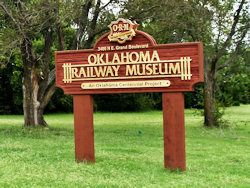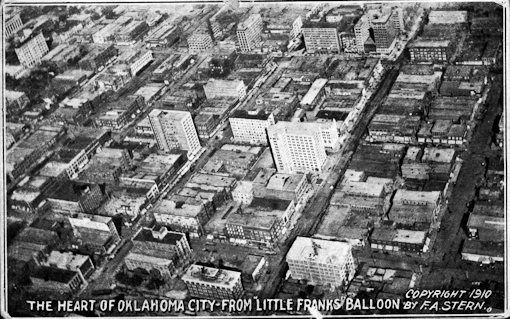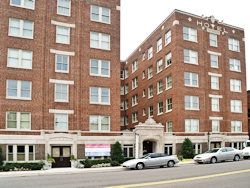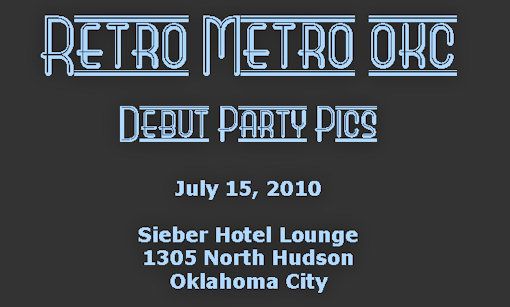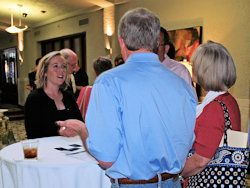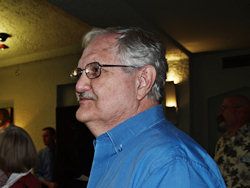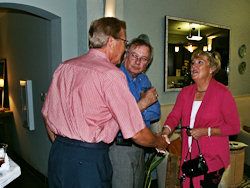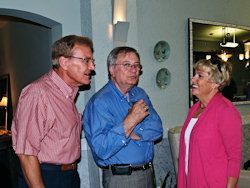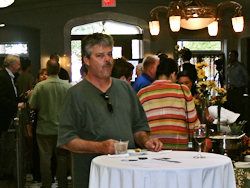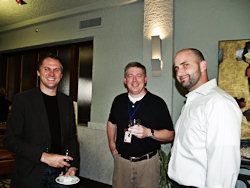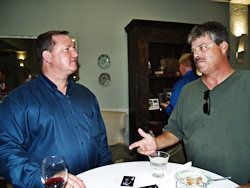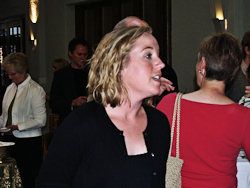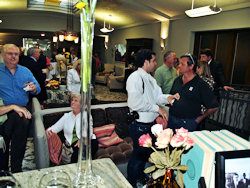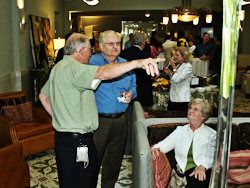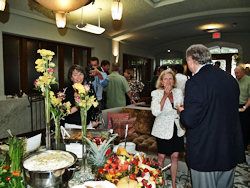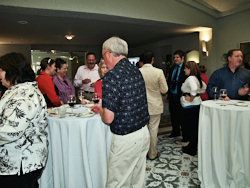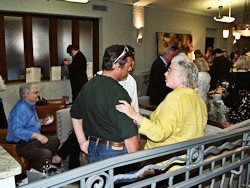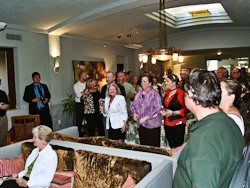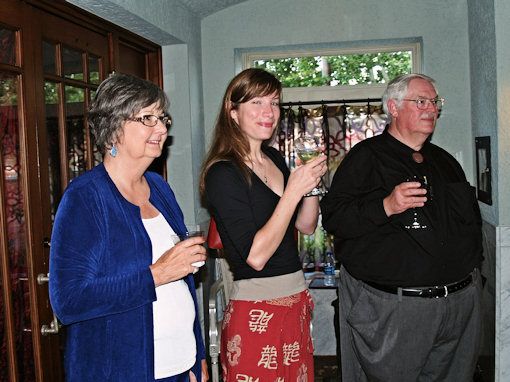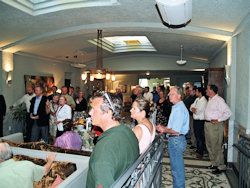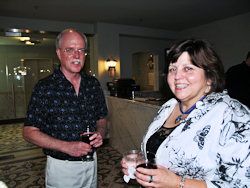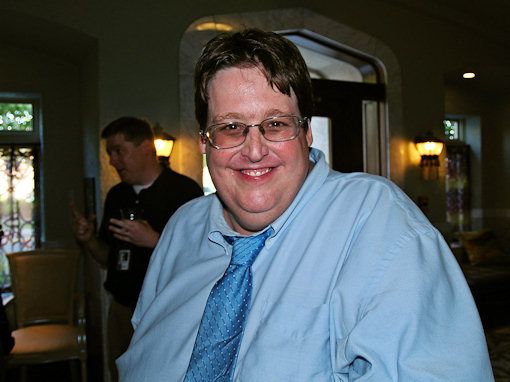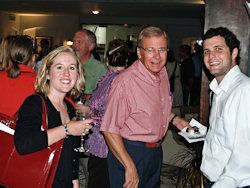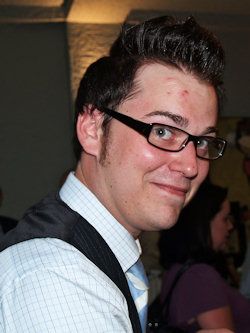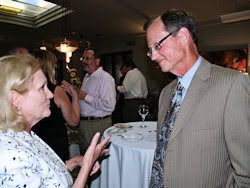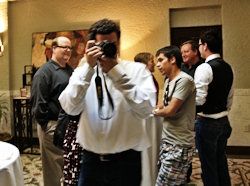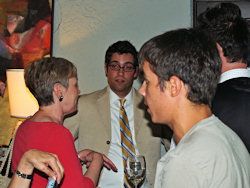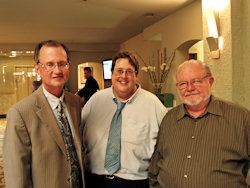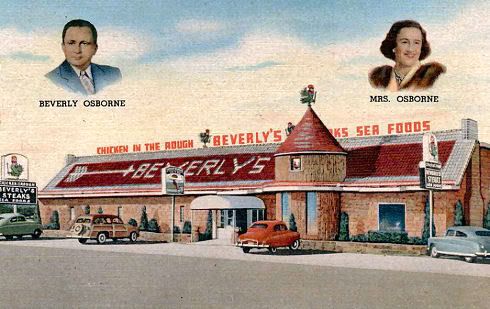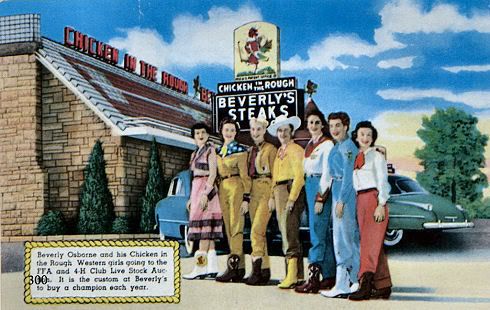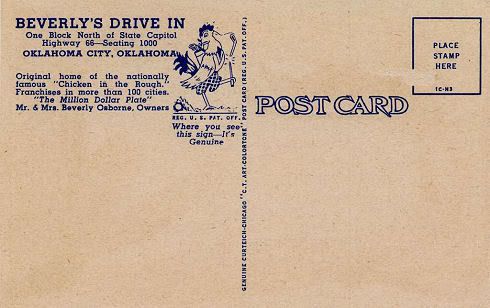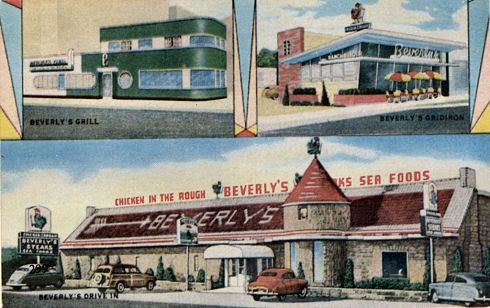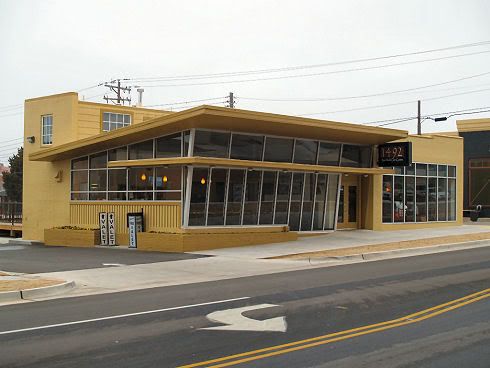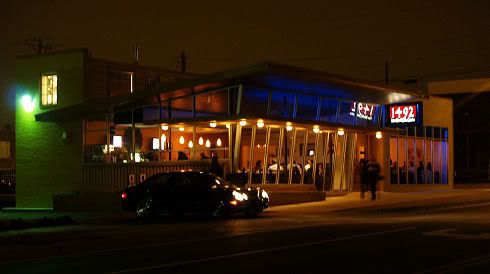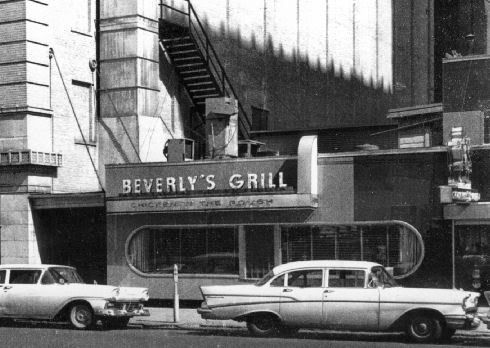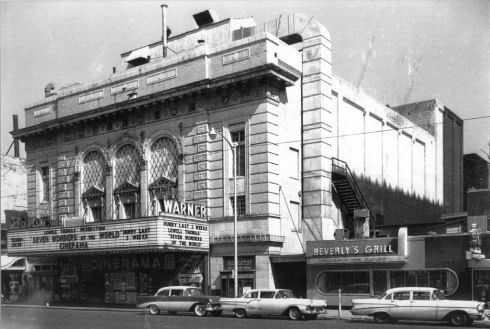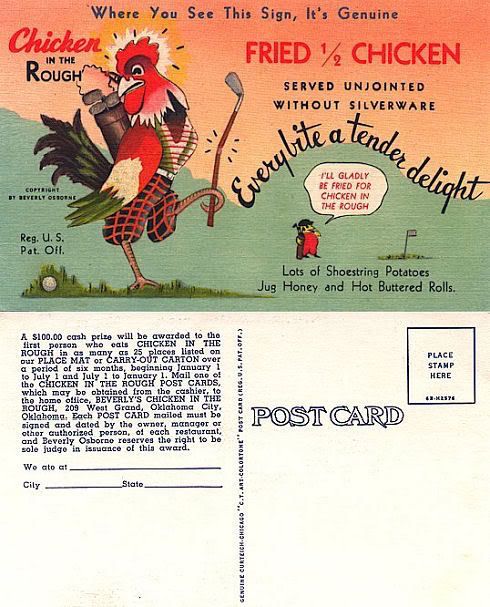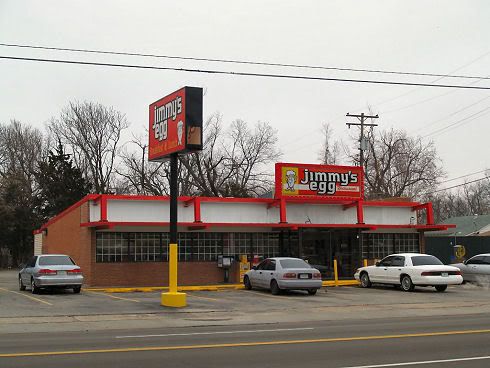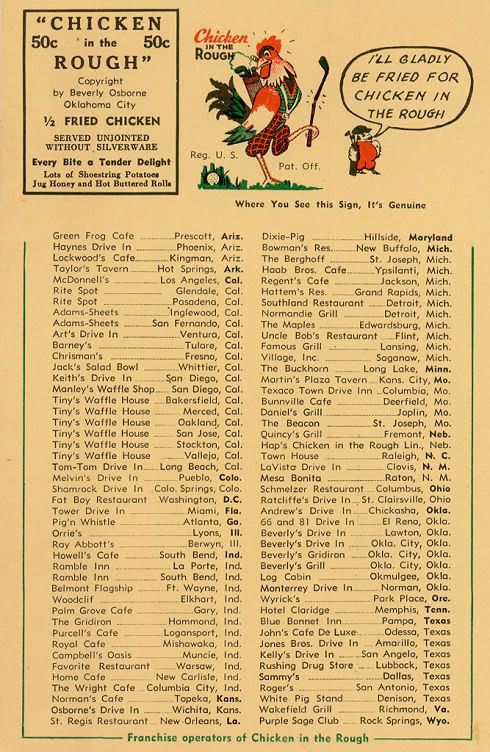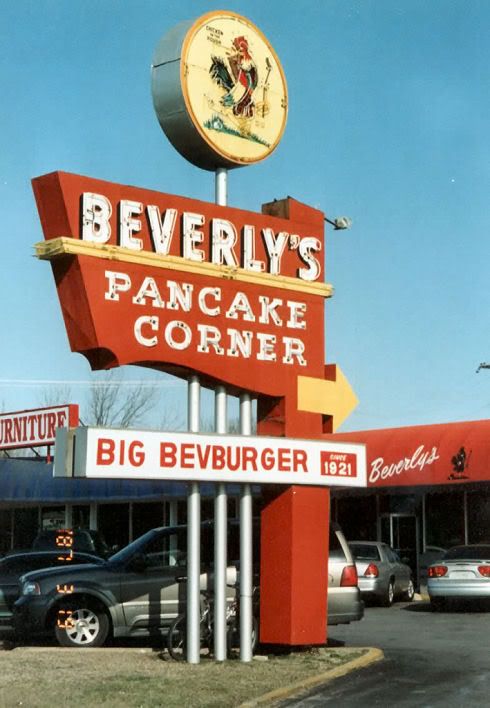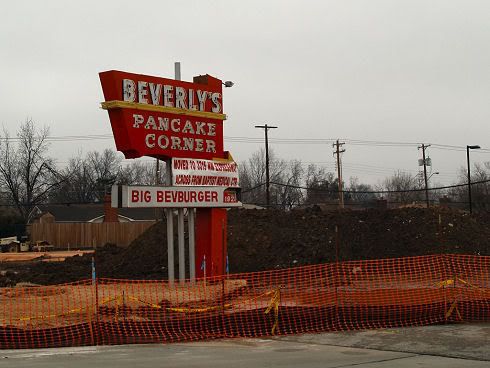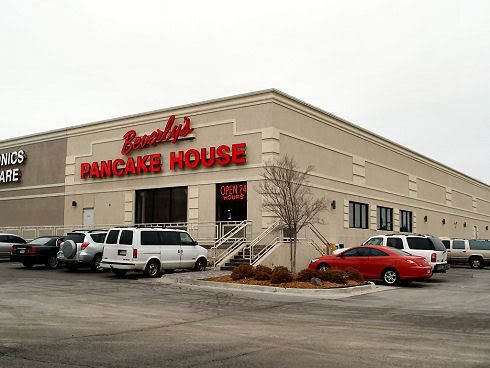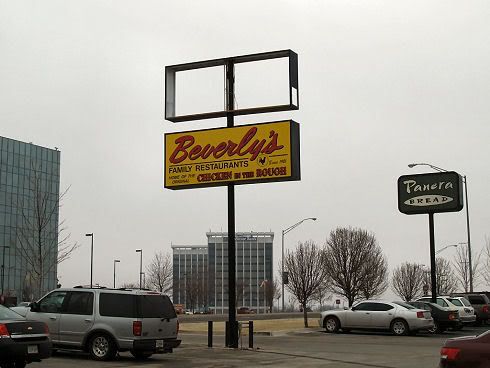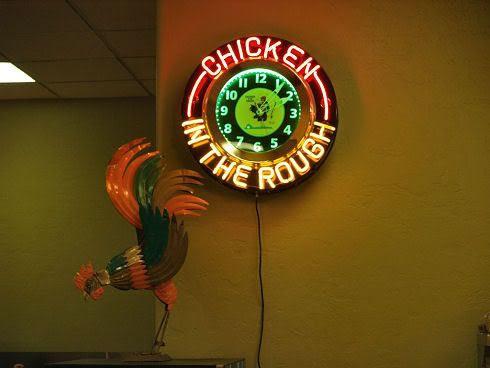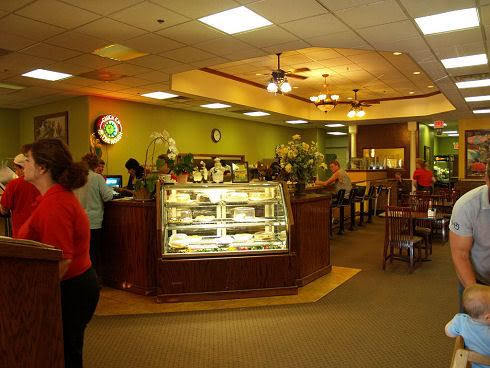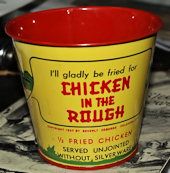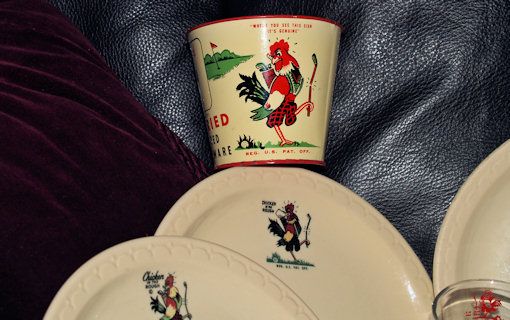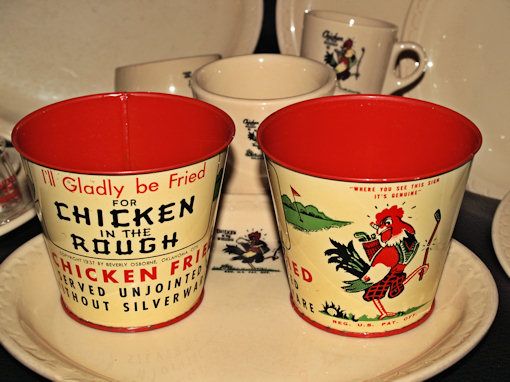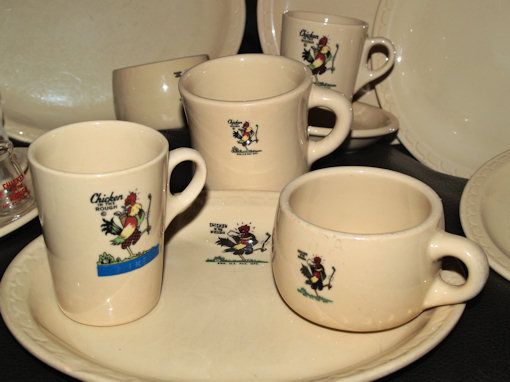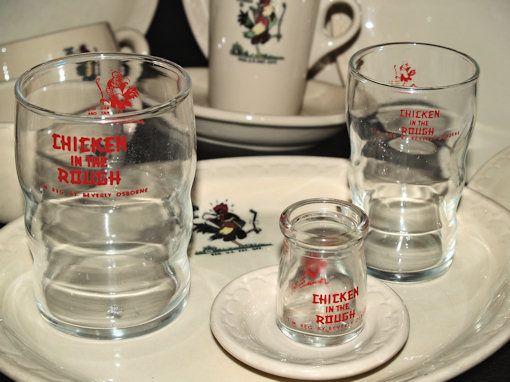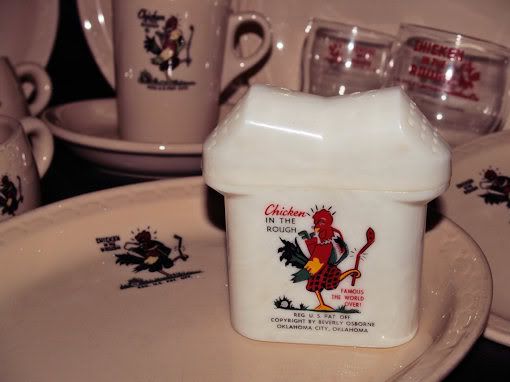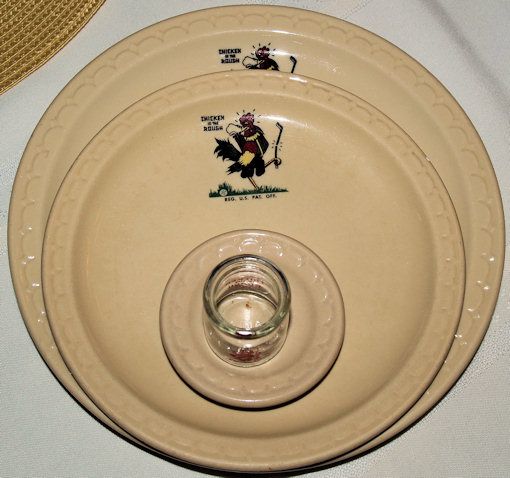The original title of this post was to be "The SandRidge Cut," as in "Director's Cut." However, it has become evident that the word form should not just be a noun but a verb, as well. I had the words done in the video below before I read Suzette Hatfield's report, published at OkcCentral.com. Were I to do the short video over again, my words wouldn't be as benign as those used in the opinionated video below. An earlier, and more hopeful and optimistic, version of the video was contained in an earlier post but at this late date I can find no cause for persisting in the hope that SandRidge has ANY willingness to compromise and be the type of corporate citizen that Kerr-McGee and its chair, Dean A. McGee, were in days gone by. SandRidge, and its corporate leaders, are not, in my opinion, in the same league. The text of Ms. Hatfield's remarks is fully set out below, as are my observations about them.
Originally, this post was intended only to present to you four documents which were filed with the City Clerk late last week, and I will do that shortly. But the publication of the following at OkcCentral.com injects a sobering and malevolent tone to the matter set for hearing before the Oklahoma City Board of Adjustment tomorrow (Monday) at 1:30 pm in the City Council chambers.
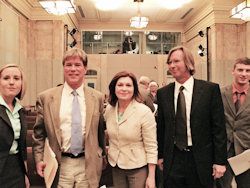 Suzette is the Treasurer and board member of Preservation Oklahoma, Inc., the appealing party from the Downtown Design Review Committee's earlier decision. She is in the center of the photograph, at right. My personal observations of her are that she is an excellent and articulate presenter of information and that what she states as fact are trustworthy reports. Fellow Oklahoma City area blogger Nick Roberts has also published this letter/comment by Ms. Hatfield.
Suzette is the Treasurer and board member of Preservation Oklahoma, Inc., the appealing party from the Downtown Design Review Committee's earlier decision. She is in the center of the photograph, at right. My personal observations of her are that she is an excellent and articulate presenter of information and that what she states as fact are trustworthy reports. Fellow Oklahoma City area blogger Nick Roberts has also published this letter/comment by Ms. Hatfield.The text of Ms. Hatfield's lengthy but imminently worthwhile comment in OkcCentral.com is the following:
| Comment by Suzette Hatfield on July 24, 2010 @ 4:19 pm So, what’s happening with Preservation Oklahoma? We were inclined to stay out of the conversation this weekend, to lie low and let the wind blow around us. However, there have been so many questions and speculations about what has happened lately that I decided to post to clear the air. Let me make it perfectly clear that I am posting as me, not as the official spokesperson for Preservation Oklahoma. When I say “we” in this post, I believe I am reflecting accurately things that our appeal group has seen together and consensus that we have reached. On Tuesday of this week, Ralph McCalmont called POK to extend an invitation from SandRidge Energy to tour the buildings slated for demolition. He said that this would also be a good time to have a conversation about collaboration and compromise. We were a bit surprised to have the offer coming from McCalmont, because he has been known as a preservationist and was POK’s first president. Katie Friddle accepted the invitation and asked for inclusion of Barrett Williamson, myself and Marva Ellard. No problem. McCalmont later phoned Katie and said that he had invited others to join the tour, including two former POK presidents and another POK board member. We reported for the tour at 8:00 AM on Wednesday, where we were greeted cordially by the SandRidge contingent, consisting of Marsha Wooden (VP, Administration), Rick Brown (Facilities Director), Allen Brown (architect, FSB), Aaron Young (architect, Rogers Marvel), Stan Lingo (structural engineer, construction manager) and Steve Ford (structural engineer). We were supplied with flashlights and toured 107 Robert S. Kerr (India Temple), 125 RSK (YMCA) 135 RSK (Connector) and 300 N. Robinson (Oklahoma Savings and Loan or KerMac). We also toured the Braniff Building which is not on the demo list. We were surprised to find the India Temple in quite good condition. It does not meet current code but that is to be expected of a building of that age and lack of maintenance. The building (and this is common to all of them except the Braniff) has been completely stripped. A great deal of original brick remains on the facade under the plaster panels. That brick is a beautiful warm brown color and is in good shape. Original window openings exist on the south, west and north sides of the building. There are no structural cracks around the windows. We are confident that this building is a strong candidate for mixed use. It was under contract for development at the time SandRidge acquired the buildings from Anadarko. The YMCA could possibly be restored for mixed use but it would be a dilly of a project because prior owner removed about 15 feet from the front of the building. Ouch. There is really not much to work with here. The Connector was built as such in 1959. As someone else who toured said, “This is a preposterous piece of crap.” Nothing at all to recommend it as a project. The OK Savings and Loan is a great building. Certainly, it needs updating to meet current code but it would be a prime candidate for mixed use development. Except for window modifications made in the 1960?s, the original facade remains in good condition. In our opinion, it is in about the same condition as the Braniff Building. There are only two real differences between the OK Savings and Loan and the Braniff: (1) There is a bit of original crown molding, marble and signage left in the Braniff, whereas the OK Savings has been stripped. (2) The Braniff is on the National Register. During the tour, when we asked Mr. Ford about the buildings’ condition, he would only speak to the fact that they do not meet the current seismic code and would be seriously damaged during a significant seismic event. After the tour, we were escorted to the executive conference room where we were offered refreshments. Marsha Wooden began by indicating that SandRidge was surprised at POK’s opposition to the project because they thought they had covered all the bases, having contacted the SHPO and having had some sort of analysis done by Dian Everett. Tom Ward came in at this point and said that SandRidge's motto is "grow or die." He said that accomplishment of their entire “master plan” was key to this strategy and that, if they do not get their entire plan approved, they would have to consider whether or not downtown Oklahoma City is the appropriate place to grow the company. So, for those of you who wondered whether or not Frank Hill had the authority to say those words at the Board of Adjustment — yes, he did. Aaron Young showed us a presentation about the planning process for the SandRidge Commons and showed some representations of the Braniff Building with a new glass wall with projections that would replace the back parti-wall. We had the opportunity to ask some questions about the project. The dense landscaping plan had bothered me as a safety hazard so I asked if the company had a plan to secure the site from those seeking temporary housing. Marsha Wooden said that they have a competent security detail and will have a lot of cameras to keep the area secure. Their officers have already worked with OCPD to run off meth smokers. POK sees several ways the company can grow on the existing site, without removing the India Temple and the OK Savings. Barrett asked if they would consider any compromise to their master plan. We were told, unequivocally, “No.” Marsha Wooden repeated, in the nicest and most attractive way, that the company would consider moving out of downtown if their master plan is not approved. We were surprised at this point when Ralph McCalmont addressed us and asked us to just, “Swallow the bitter pill” and cease our opposition to the project at that moment. He told us that Preservation Oklahoma would find itself “marginalized in the community” and that funding sources would dry up if we were to go forward with our opposition. He said that we would be seen as extremists and obstructionists and that it would be very difficult to be included in more important efforts, such as saving the First National Building, if we continued. Marsha Wooden said that she hoped that we would not go forward as opponents, as that would “stress City resources more than they already have been.” That pretty much concluded the event. We were grateful for the opportunity to tour. Later in the day, Katie received a follow-up call from Mr. McCalmont repeating some of his comments, including his dire forecast for the future of POK if we continued in our position. We found out that board members were receiving calls from Mr. McCalmont and others and that folks who had been friends and contributors to POK were receiving calls asking them to pressure us to stop. For awhile we were worried that there may actually be a groundswell of support in the business and civic community for SandRidge. For a millisecond, we doubted ourselves. Then, after a little due diligence, we found out that it’s just the same old folks behind the screen, tripping the little levers that release the smoke and mirrors. It turns out that this is what happened… SandRidge hired a PR guy named Brent Gooden to wipe up the mess left by their inept handing of this project. Gooden has been behind almost every statement or document that has been pro-SandRidge. The op-eds in the paper? The letters to the editor? Yes, Brent Gooden wrote those and had them signed by others. I’m not saying that Ford Price, Frank McPherson and others aren’t supporting the project. They obviously are. But, it appears they didn’t spend their own time and personal energy putting their viewpoints forward. Frank Hill worked the phones and sent e-mails to some civic leaders giving them SandRidge’s perspective about the project. He urged them to get on the phone and pressure friends of POK to call off the dogs — us. I’m sure you’ll recall the last Board of Adjustment hearing when Frank addressed the board and stated that, “City Staff approved EVERYTHING in our application.” Since POK’s position is to support the staff recommendation, which was to deny four demolitions, we were puzzled. We continue to be amazed that this is the information being conveyed to these prominent people in order to enlist them in the SandRidge “army.” There has also been talk of “7500 jobs lost to downtown” if the project doesn’t go through. Who are these people? SandRidge’s “Linkedin” profile shows 2205 employees. Some of these are field personnel, not downtown office dwellers. Yes, SR just purchased Arena Resources. D&B lists Arena as having 71 employees. One long-time civic leader, who has made innumerable contributions over the years, bought into the spiel and has been making lots of calls. Others received the goods from Frank and Brent but did not drink the Kool-Aid. So, the giant groundswell of opposition turns out to be 4 people, two of whom are paid by SandRidge. Have there been threats? If you consider social and community marginalization to be threats, then surely there have been. I guess that’s the modern equivalent of shunning. They want us to take our buggy and go home. Are we worried about losing our funding? We would hate to lose money but we are on our mission and message. Preservation Oklahoma’s duty is to advocate for the brick-and-mortar history of Oklahoma. We hope there are folks who see us hard at work and want to write a check to help us go forward. And, unfortunately, we do have a business relationship that will terminate if we go to district court. I’m not going to name names here, but we have had a very successful partnership statewide that has been beneficial to both parties. We received a message that, if we go to court, we will be deemed to be “controversial and divisive” and the partnership will be over. That’s too bad because the small towns and cities where we do the projects don’t give two cents about the SandRidge Commons project in OKC. Do I really believe that SandRidge will move out of downtown if they don’t get their way? They would have to hire two dozen Brent Goodens to clean up the public relations nightmare in the wake of such a move. Can you imagine how many people would accuse them of packing up their Barbies to go home and play alone? I can’t imagine that it would be a good financial decision for them, either. They bought the complex of buildings on Robert S. Kerr for about $22/sq. ft. They have plenty of room to grow there. If they kept the India Temple and OK Savings, if they put their new recreation building north of the India Temple on Broadway and if they built a new tower at 120 RSK to mirror the existing one, they would be able to more than double the size of the company. Where else could they find prime office space for $22/sf? What will happen Monday? We don’t know. We do not believe that due process at the Board of Adjustment has been corrupted at this time. The two remaining buildings have been lumped together for one vote. We believe this is improper since the Downtown Design Ordinance gives the DDRC (and now, in its stead, the BoA) the authority to demolish A building larger than 20,000 sq ft per permit. There will be four members of the Board present and voting. Jeff Austin is permanently recused because of his contract with SandRidge. The only way that the 107 RSK and 300 N. Robinson buildings will be saved is if there is a 3-1 or 4-0 vote to reverse the decision of the DDRC. The municipal counselor produced recommendations yesterday that we consider to be way off base. The document basically says that if the Board finds that the building(s) is/are economically feasible for SandRidge’s purposes, the Board can reverse the decision of the DDRC. It says if the Board finds that the building(s) is/are not economically feasible for SandRidge’s purpose, the Board can affirm the decision of the DDRC. Yes, it really says that. Of course NONE of that is in the ordinance in ANY way. I wonder if the attorney has recovered from the thumbscrews yet. SandRidge submitted a seismic/condition assessment of the remaining buildings only yesterday. In glancing through, we thought the report was pretty favorable. Will POK appeal if things don’t go our way on Monday? We have scheduled a special meeting later in the week if we need to make that decision. |
OBSERVATIONS ON MS. HATFIELD'S REPORT. Suzette's report was clearly carefully put together and it reads clearly. But, I wanted to know a little more, if I could find it or think of it to say.
Having done that at least a little, the Tuesday call for a meeting with SandRidge was clearly an ambush, a setup, from the get-go.
First, a call is received from a respected member, the initial president, of their own organization, Preservation Oklahoma. The call came from Ralph McCalomont.
| On Tuesday of this week, Ralph McCalmont called POK to extend an invitation from SandRidge Energy to tour the buildings slated for demolition. He said that this would also be a good time to have a conversation about collaboration and compromise. We were a bit surprised to have the offer coming from McCalmont, because he has been known as a preservationist and was POK’s first president. |
I can only speculate but the call must have been the cause for at least cautious optimism — SandRidge was inviting POK for a meeting involving "collaboration and compromise," things that POK had hoped for all along. And the call came from a trusted friend.
I did a little checking and found a bit of information about this person, and, indeed, there is good reason for the trust since he has excellent credentials as a person interested in historic preservation. A September 8, 2004, Journal Record article reported that he had just been named head of a new state task force to study the economic impact of historic preservation and resigned his post as interim director of the state's Tourism and Recreation Department to accept that position. On a quick look, I was unable to found more about the new task force and what it did or did not accomplish. I as able to find that, according to Forbes, he is 74 years old, is a director of BankFirst Corporation, and is self employed in the investment and management of personal financial holdings. I also found this glowing True West Magazine article about his efforts at historic preservation in Guthrie, where he lived before moving to Oklahoma City. The article is titled, "Horse Trading for a Better Guthrie — How the power of the few brought back the 'Magic City.' " Part of that article reads,
Many nights, during the late 1970s, Ralph McCalmont had to remind himself he was trying to save Oklahoma's "magic city." Opposition was so loud and so hurtful, he wondered if it was worth it.So, like Preservation Oklahoma's present circumstance, he had been there, done that, and was presumably a person that POK could trust.
Before the meeting, POK was graciously received and the delegation was granted the building tour that they had been seeking to have for months but which SandRidge had not allowed until this past week.
And, then came the meeting McCalmont had said was for the purpose of "collaboration and compromise." In the executive conference room, refreshments were offered and everyone was polite. Eventually, a timely visit was made by Tom Ward to the group, and he said unequivocally that,
| SandRidge’s motto is “grow or die.” He said that accomplishment of their entire “master plan” was key to this strategy and that, if they do not get their entire plan approved, they would have to consider whether or not downtown Oklahoma City is the appropriate place to grow the company. |
Any lingering doubt about SandRidge's willingness to consider compromised was quickly dashed when Marsha Wooden replied to Barrett Williamson's query — would SandRidge consider ANY compromise? "No." the company would consider moving out of downtown if their master plan is not approved.
And then, rubbing salt into the wounds, POK's presumed friend, Ralph McCalmot addressed the invited guests who were told by him to "swallow the bitter pill" and cease opposition to SandRidge's plan, then and there, right at that very moment. Otherwise, POK would find itself "marginalized in the community," funding sources would dry up, the group would be seen as extremists and obstructionists.
After the meeting, McCalmot called Katie Friddle and repeated what he'd already said. Board members received calls from McCalmont and others and people who had been friends and contributors to POK were receiving calls asking them to "pressure us to stop."
More, without naming the corporation, Hatfield said that POK had been informed that it the pending dispute is carried to district court (the next step by whoever the loser is at today's hearing before the BOA), an existing business relationship with a company that she did not name will be terminated and that that partnership "will be over."
Ralph McCalmont — some friend. Ralph McCalmont — some compromise meeting. Ralph McCalmont — will have great lengths to go to before being able to be trusted by Preservation Oklahoma ever again.
So, what began as a day of possible hope ended with quite a different reality. Setup. Ambush. Quit or die.
I assume that POK will show up at today's 1:30 pm meeting before the Board of Adjustment in City Council chambers.
DOCUMENTS FILED WITH THE CLERK LAST WEEK. Late last week, the following documents were filed with the City Clerk which relate to tomorrow's hearing and decision by the Board of Adjustment:
- SandRidge's Structural Study. This July 22 report by an expert employed by SandRidge, Zahl-Ford, Inc., assesses the India Temple in a study named, "Limited Structural Assessment and Seismic Evaluation." The same company apparently performed a study of the Oklahoma Savings & Loan Building but I do not have a copy of that. What would really have been interesting to see was a similar study of the Braniff Building which SandRidge does not intend to demolish.
- Preservation Oklahoma's Reply. This is Preservation Oklahoma's reply to the above in a brief July 23 letter by Katie Friddle, its Executive Director.
- Municipal Counselor's Office Opinion. This apparently unsolicited opinion advises the Board of Adjustment, undated and unsigned, of its thoughts about the manner in which the BOA should handle its decision tomorrow.
- Frank Hill Letter. This July 22 e-mail letter by Mr. Hill to J.J. Chambless, Clerk of the BOA, transmits item (1) for filing and advises of the possibility that an additional Power Point presentation may be made tomorrow.
UPDATE: APPEAL DENIED. By a 3-1 vote in a meeting which lasted only about two hours, Preservation Oklahoma's appeal was denied at yesterday's hearing, David Wanzer being the only member to vote against the motion made by Jim Allen to affirm the action taken by the Downtown Design Review Committee. Although I was unable to be present at the start of the 1:30 pm meeting, I did arrive by around 2:15 or so and the meeting was over by around 3:30. Actually, in my opinion, it was over before it started. An article on the meeting by Steve Lackmeyer appears here and blogger Nick Robert's take on the meeting can be read here.
In a remarkably brief discussion by members of the commission (compared to the earlier sessions), only 2 members contributed to the discussion, Michael Dunn and Jim Allen. Neither Rod Baker nor David Wanzer had an opportunity to speak before a motion was made and seconded to deny the appeal. Board discussion began with commissioner Dunn opining that it was not economically viable that the India Temple and Oklahoma Savings and Loan be restored and converted to mixed commercial and residential use and that the residential problem would be exacerbated by an inadequate supply of nearby parking. Jim Allen, who was on record as favoring saving the India Temple, did a quick about face, as you will hear below. I didn't catch all of the discussion in the video clip below, but of the 2 minutes and 3 seconds which I did capture, the remainder could not have lasted more than an additional minute. Jim Allen moved that the decision of the Downtown Design Review Committee be affirmed (in a rather awkwardly presented motion), I think (but am not certain) that commissioner Dunn seconded the motion, and it was promptly put to vote. Only commissioner Wanzer voted against the motion, and it was done that quickly, Rod Baker voting with the majority. Very evidently, the final session was merely a formality and the commissioners had their minds made up before the session began.
| During SandRidge's presentation, its CEO, Tom Ward, made a statement not made previously about the SandRidge Commons proposal. He said, "If we need to grow, we'll use the block to grow," but did not identify the part of the new plaza that would be expendable for that purpose. |
Except for the clip from a KFOR-TV video showing Tom Ward, the photos and video clips shown below were taken using my cell phone, so the quality is not so hot but is better than nothing.
The following photos are of various people seated in the audience or speaking to the members of the board. Click on a photo for a larger view.
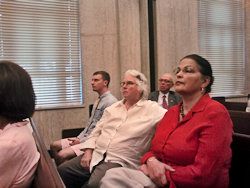 | 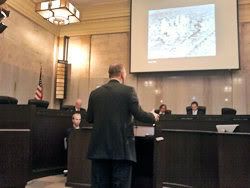 |
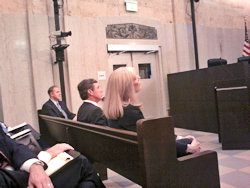 | 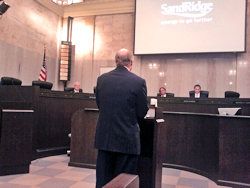 |
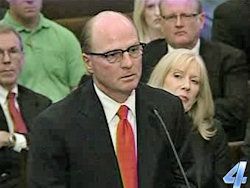 | 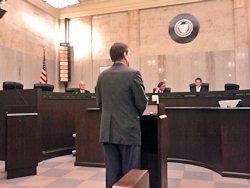 |
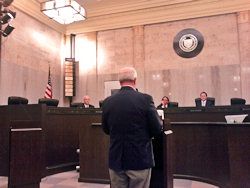 | 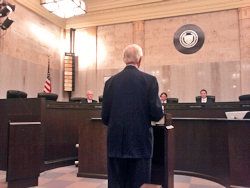 |
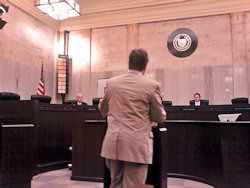 |  |
Barrett Williamson, 8 minutes 56 seconds
2 minutes 3 seconds
CONCLUDING OBSERVATIONS: PROCEDURAL. Although I'm 67 years of age, until sitting in on the Board of Adjustment proceedings on this matter, I've never closely followed any municipal proceeding before, so this was a new experience for me. Now that it is done, I'm reflecting on the process that I've witnessed — things that are important, things that are not, things that go on behind the scenes, the importance of procedure, the importance of power.
One thing that I've learned from this experience is that my background in the legal system — courtroom procedure, rules of evidence, rules pertaining to appeals, etc. — did not serve me well in providing expectations as to what would occur in a municipal procedural context. The contexts are completely dissimilar and the rules are not even remotely the same. More precisely, my conclusion is that there are no rules in the municipal appellate context. Anything goes. Because of my naiveté, I did not know what the municipal context was all about.
Appellate Context. In courts of law, except under very unusual circumstances, an appeal from a decision of a lower court is limited to the evidence presented in the lower court. Arguments during an appeal are generally based upon whether the lower court erred in its determination of the applicable law and/or whether the evidence presented in the lower court was sustained by the applicable measure of proof required — in most cases, by a "preponderance of the evidence," in others by "clear and convincing evidence," and in criminal proceedings, "beyond a reasonable doubt." New evidence is ordinarily not possible to be presented. I naively figured that an appeal from the Downtown Design Review Committee's decision would be fairly parallel to an appeal in a court of law.
In this proceeding, it quickly became evident that I was badly mistaken — this was much more like a trial de novo — effectively a separate and distinct trial — with old and new evidence submitted as the parties would care to present.Trial Context — Surprise Evidence. In courts of law, in non-criminal cases at least, a pretrial conference will ordinarily occur. Before that conference occurs, each party is afforded the opportunity to conduct "discovery" (vastly oversimplified, the process of obtaining information from the other side or from witnesses other than the parties) and "discovery" will need to be completed prior to a pretrial conference hearing. At that pretrial hearing, parties are required to identify witnesses they may call to testify and documents they may offer for introduction as evidence during the trial. If witnesses or documents are not identified at this hearing, they are ordinarily precluded from being utilized during trial. A party cannot simply pop-up a new witness or a new document on the eve of trial and have a remote chance of it be received as evidence during trial unless no objection is presented by the other side. In this municipal proceeding, it was not only allowed but it was apparently the norm as may well be true for other municipal proceedings, I don't know. In this proceeding, an expert's written report as to structural and seismic integrity was filed four (4) days prior to yesterday's hearing and was part of the evidence considered by the Board of Adjustment.
During Barrett Williamson's remarks, above, he inquired, "Is the board considering this new information," and the reply from Chairman Wanzer was, "It's on the record," which was to say, "Yes." In other words, if a document is filed with the Clerk, or even presented during the hearing itself, that would be sufficient for it to be considered.Hearsay. Hearsay evidence (oversimplifying greatly, evidence/testimony of what someone not present in court to testify, e.g., "Bob Blackburn told me that ... " when Mr. Blackburn is not a witness in the case) is generally disallowed if an objection is presented. Rampant hearsay was presented by both sides during these proceedings with nary an objection. One can only wonder what would have happened were such an objection to have been presented, but I have no doubt that it would have been overruled. That non-rule is part of the municipal procedure that I witnessed.
Out-of-Court Information. In courts of law, the "evidence" is that submitted by the parties during the course of trial. Non-procedural communications between judges, lawyers, witnesses, and others related to the pending matter which are not made during trial are strictly disallowed and may be the basis for bar association or judicial disciplinary proceedings if they do occur. During Barrett Williamson's remarks, above, one commission member interrupted him to remark and state as a fact that Park Harvey Apartments' occupancy rate had dropped from 92% to 49% before and after Devon acquired the municipal parking garage south of those apartments. Perhaps Mr. Tannenbaum testified to that in an earlier hearing although I have no such recollection and do not think that he did. If Tannenbaum did not so testify, what was the source of those statistics presented by the commissioner, and how and by whom were they communicated to the commission member who made the remark? Ex-parte communications to members of the panel may well be OK in the municipal context, and may well have occurred, even though they may be grounds for serious discipline in the courts-of-law context. If this happened, in my estimation, it is an incredibly grievous error for it to be permitted or tolerated and it was wrong, ethically if not legally, by the person giving and by the person receiving the communication.
Relevance of Evidence. In courts of law, evidence must be "relevant," i.e., under the law involved, it must be relevant to a fact decision to be made in the case. So, if a particular statute is involved which will decide the issue, the evidence needs to relate to the statutory language which is involved. In a municipal proceeding context, that is apparently not the case. At least, I'm not aware of anything involved with the municipal ordinances involved in this proceeding which make letters or e-mails (from either side) which extol the position of one side or another as being relevant as to whether ordinance requirements were being followed or not. Such things were abundant in this case, on both sides.
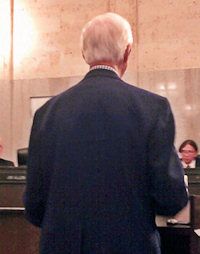 I could go on — such as the right to cross-examine witnesses (wouldn't it have been fun, for example, to inquire of Ralph McCalmont under oath how it was that he became involved in this proceeding, who (if anyone) contacted him to do so, his conversations with those who did, who he contacted and what he said, and so on — talk about a lawyer's field day!) — but the above is enough to make the point — courts of law are one thing and municipal proceedings are apparently quite another.
I could go on — such as the right to cross-examine witnesses (wouldn't it have been fun, for example, to inquire of Ralph McCalmont under oath how it was that he became involved in this proceeding, who (if anyone) contacted him to do so, his conversations with those who did, who he contacted and what he said, and so on — talk about a lawyer's field day!) — but the above is enough to make the point — courts of law are one thing and municipal proceedings are apparently quite another.The teaching point, I suppose, is that one would be badly misguided into thinking, and planning as to how to proceed, in supposing that municipal hearings are reasonably akin to what occurs in a court of law. Quite possibly, in its naiveté, Preservation Oklahoma misjudged the "rules of the game" just as badly as I did myself.
CONCLUDING OBSERVATIONS: SUBSTANTIVE. Unless common sense and logical thought processes be completely abandoned, a fair conclusion is that something occurred between the last BOA hearing and the one which occurred this past Monday. Earlier, there were serious concerns raised by some of the commissioners about various aspects of the DDRC decision. But, on Monday, following the presentations, in a 3-minute time span, the board discussed the matter for about 2 minutes, only 2 members making any comments during that time, and then in an additional minute a motion was made, seconded, and adopted by a 3-1 vote –– all of that occurring in just 3 minutes of time.
How did it happen that the previous concerns of the board suddenly became condensed to a 2 minute discussion and 1 minute for a motion to be made, seconded and voted upon?Opinions may vary, but here are mine. In retrospect, there are a few things that can be looked at, and one of them is the report made by Suzette Hatfield on July 24, the Saturday before Monday's BOA meeting. You'd need to read her full comments to get the full picture, but one of the most important pieces of information centers around Ralph McCalmont, 1st president of Preservation Oklahoma and a person with established historic preservation credentials — in other words, someone that Preservation Oklahoma had good reason to trust.
On SandRidge's behalf, he invited POK representatives to come to SandRidge for a meeting which would include a tour of the buildings involved — which POK had long sought and been denied — and at which meeting the long hoped-for compromise would be discussed.
Now, I'm not a member of POK and am not privy to more information than anyone else about them. BUT, were I Katie Friddle or Suzette Hatfield, I would have taken hope in Ralph McCalmont's invitation — the invitation came from a friend who conveyed the message, at long last, that SandRidge was willing to discuss compromise with Preservation Oklahoma.
According to Ms. Hatfield, the "compromise" discussion proved to be anything BUT that. After the tour and in a meeting held in SandRidge's executive conference room with courteous refreshments provided, POK was told in no uncertain terms that SandRidge was completely unwilling to vary one iota from its plan. More, Ralph McCalmont (not SandRidge, but instead its envoy, McCalmont) insisted that POK drop its appeal, right at that moment, else it would suffer the consequences of being marginalized, seen as extremists, and suffer loss of financial support.
Ms. Hatfield also reported that after the meeting that POK board members were receiving calls from Mr. McCalmont and others who had been friends and contributors to POK asking them to pressure POK to stop. POK also learned that at least one business relationship it has had over a lengthy period of time would terminate if POK pursued the matter to district court.
Thinking back on that pre-BOA hearing knowledge and after the fact, was the loss before the BOA a foregone conclusion?What was the corporate sponsorship that would be lost if an appeal was filed? Now, I won't express an opinion about that ...
... but I will note that McCalmont is a director of BankFirst Corporation ...One question that occurs to me to wonder about is this: Where was Mr. McCalmont during all of the preceding months that this matter had been under discussion and consideration before the DDRC and then by the BOA? If his concerns in fact existed earlier than last week, why was he reticent about saying so much earlier than then? If his new wisdom was only found last week, what and who was the source of his epiphany?
It is also a concern of mine during Monday's meeting while one POK speaker was addressing the board that commissioner Michael Dunn interrupted the speaker and made a factual statement that Park Harvey Apartments had suffered an occupancy decline from 92% to 49% after Devon acquired the city parking garage for use with its new office tower. Now, I don't know whether those alleged facts are true or false. I do know that I have followed these proceedings closely and IF there has been any testimony or presentation by anyone to such facts I have certainly missed it and I don't think that I have.
IF THAT BE TRUE, where did the information that Michael Dunn reported come from? From evidence presented during the proceedings? If it wasn't from that evidence, it came from somewhere else and from someone outside the record of the proceedings.
Then, consider the remarks by board member Jim Allen during the 2-3 minute discussion by the board on Monday. He said, with regard to the India Temple building,
After further looking at that, I think I made a mistake. After looking at what we've got here, I would say that we need to move forward.Holy-About-Face, Batman! Allen offered no reasons for why he'd reversed his position; he merely said, "We need to move forward."
Investigate as you will and reach your own conclusions. If my opinions are incorrect, on fair evidence being submitted I'll be glad to reconsider — I am just an outsider trying to look "in" to a very non-transparent process about which I'm an outsider, but, as it stands, the "in" doesn't strike me as being very pretty, not very pretty at all.
The odd thing in all of this, as I've said from my very beginning post in the SandRidge posts at OKC Talk.com, is that I can easily see that the SandRidge Commons can be a very good thing for the city ... even though I hedged my initial post there upon the potential viability of the India Temple ... but ... the thing is, the underhanded manner, in my opinion, in which this has been carried forward by SandRidge is, to me, wholly abhorrent and brings shame upon our city, to its municipal processes, and, since I'm a part of this city, to me. Those are my opinions about that but form your own as you will.
Related articles:
- Appeal by Preservation Oklahoma
- SandRidge Proposal -- What Have We Got To Lose?
- Hugging Our SandRidge Buildings
- SandRidge Commons - What About Door #3?
- National Trust For Historic Preservation Weighs In
- SandRidge - Holder of a Legacy
- Bye Bye Miss American Pie
- SandRidge and Restoration

